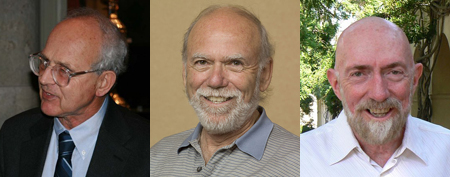This year's Nobel Prize in Physics has gone to Rainer Weiss, Barry C. Barish and Kip S. Thorne "for decisive contributions to the LIGO detector and the observation of gravitational waves".
A computer simulation of two black holes merging. The simulation shows the gravitational waves caused by this event. Credit: Max-Planck-Institut für Gravitationsphysik (Albert-Einstein-Institut).
As their name suggests, gravitational waves are connected to the force of gravity we are all familiar with. In 1687 Isaac Newton formulated his universal law of gravitation, which describes the gravitational attraction between two massive objects. The law remained unchallenged until 1905, when Einstein published his special theory of relativity. The theory says that there is a universal speed limit in the Universe: nothing can travel faster than light, that is, nothing can travel faster than roughly 300,000 km per second. This contradicted Newton, who thought the effect of gravity was instantaneous: take away the Sun, and the effect will be felt on Earth immediately.
Einstein himself later remedied this problem by proposing that gravity isn't a force that wafts across the ether in some mysterious way, but a result of the curvature of space. An analogy that is often given is that of a bowling ball sitting on a trampoline. The ball creates a dip in the trampoline, curving its surface, so a marble placed nearby will roll into the dip towards the ball. According to Einstein, massive bodies warp space in a similar way, causing less massive bodies to be attracted to them (find out more here).

The 2017 laureates. From left to right: Rainer Weiss (image by Michael Hauser), Barry Barish, and Kip Thorne (image by Keenan Pepper).
One of the consequences of Einstein's theory of gravity is that when gravitational monsters such as black holes shunt their weight around, they should create ripples in the very fabric of spacetime. These ripples are the gravitational waves researchers at the Laser Interferometer Gravitational-Wave Observatory (LIGO) had been looking for.
In 2016 they rewarded by a discovery that counts as a major milestone in modern physics. Rainer Weiss received one half of the Nobel Prize for his part in the detection of gravitational waves by LIGO, and Barry Barish and Kip Thorne share the other half. "The 2017 Nobel Laureates have, with their enthusiasm and determination, each been invaluable to the success of LIGO. Pioneers Rainer Weiss and Kip S. Thorne, together with Barry C. Barish, the scientist and leader who brought the project to completion, have ensured that more than four decades of effort led to gravitational waves finally being observed," says the Nobel Prize website.
We recently had the pleasure to attend a lecture by Kip Thorne and to interview Gabriela Gonzáles, Professor of Physics at Louisiana State University and former spokesperson of the LIGO Scientific Collaboration. The resulting videos and articles tell you everything you need to know about gravitational waves: the track the long theoretical quest to confirm Einstein's predictions, the technical quest to hear the tiny echoes of gravitational waves when they finally meet our detectors, and the secrets they may reveal in the future. To watch the videos and read the articles, see Stuff happens: Listening to the Universe.
Congratulations to all three laureates!